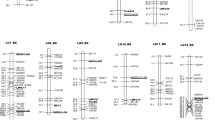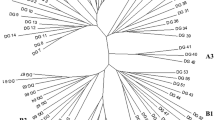Abstract
Amplified fragment length polymorphism (AFLP) analysis is a rapid and efficient technique for detecting large numbers of DNA markers in eucalypts. We have used AFLP markers in a two-way pseudo-testcross strategy to generate genetic maps of two clones of different Eucalyptus species (E. tereticornis and E. globulus). Of 606 polymorphic fragments scored, 487 segregated in a 1 : 1 ratio, corresponding to DNA polymorphisms heterozygous in one parent and null in the other. In the maternal E. tereticornis map, 268 markers were ordered in 14 linkage groups (919 cM); the paternal E. globulus map had 200 markers in 16 linkage groups (967 cM). Results from PGRI software were compared with MAPMAKER. The average density of markers was approximately 1 per 3.9 cM. Framework markers were ordered with an average confidence level of 90%, covering 80–100% of the estimated Eucalyptus genome size. In order to investigate the homologies between the E. tereticornis and the E. globulus genetic linkage maps, we included 19 markers segregating 3 : 1 in the analysis. Some homeologous linkage groups were recognized. The linkage data developed in these maps will be used to detect loci controlling commercially important traits.
Similar content being viewed by others
Author information
Authors and Affiliations
Additional information
Received: 17 July 1997 / Accepted: 13 October 1997
Rights and permissions
About this article
Cite this article
Marques, C., Araújo, J., Ferreira, J. et al. AFLP genetic maps of Eucalyptus globulus and E. tereticornis. Theor Appl Genet 96, 727–737 (1998). https://doi.org/10.1007/s001220050795
Issue Date:
DOI: https://doi.org/10.1007/s001220050795




